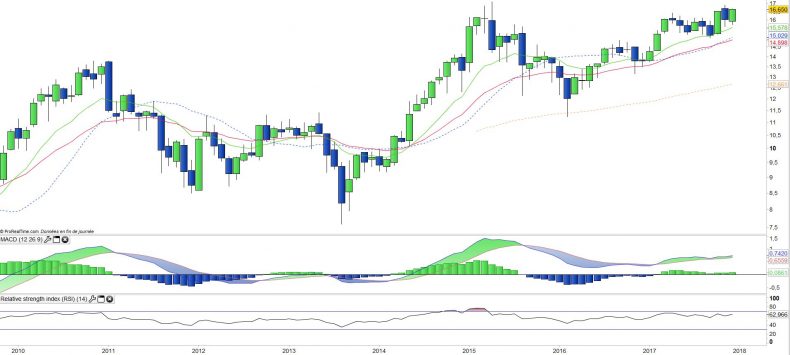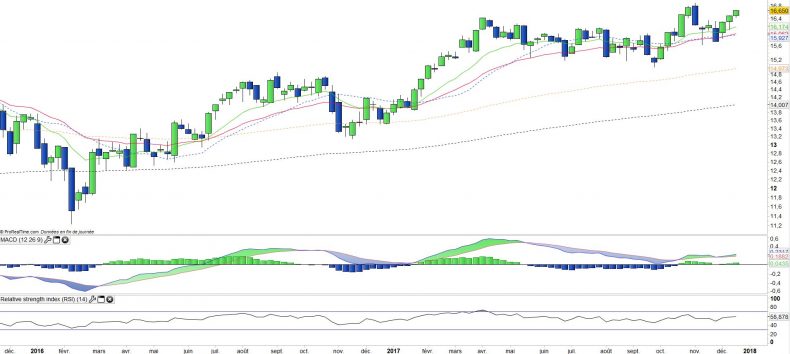Lyxor ETF India - INR - 27/12/2017
Short Term strategy : Positive (100%) / Trend +
Long Term strategy : Positive (100%) / Trend +
Characteristics of the ETF
The INR ETF (Lyxor UCITS), created in 10/2006 and quoted in Euro on Euronext replicates the MSCI Net Emerging Market India index and represents 85% of the total market capitalization of India. Although the index that is replicated is listed in USD, it is composed of 79 Indian values, which implies an exposure to the local currency, the Indian rupee.
The ETF costs are in the upper part of our sample and stand at 0.85% while AUM amount to € 1 369m. The replication method is indirect (via a swap) and there is a dividend capitalization policy.
Alternative ETFs: INDA (iShares in USD), CI2 (Amundi in Euro)
Index & components
The interest of the INR tracker is twofold, it allows in the first place to bet on the most dynamic and promising emerging economy of the world while the important sectorial diversification ensures a very satisfactory coverage of the Indian economy with a high proportion of 'growth companies. The significant share of the technology sector (14.4%) - which includes notably Infosys - in the index, seems to us an asset with regard to the quality of the IT / Software sector in India including leading players.
The index also seems to be well balanced in terms of sectors, with 23.2% for financials, 7% for health, 13% for consumer discretionary, 12% for energy, industry's share trend to increase with 9.8% for materials and 9.5% for durable goods.
India, whose GDP is expected to reach $ 2600bn in 2017 (ie to reach or even surpass France at the 5th rank in the world) has shown better resistance than other emerging countries to the slowdown in global growth in 2015, compared to China, the Brazil or Russia, insofar as it benefited from the decline in oil and is not impacted by the fall in commodities. Growth strengthened in 2016, reaching 7.6%, making the Indian economy the most dynamic in the world. Mr Modi is progressing slowly in his reform objectives, due to a lack of majority in the parliament, but records successes notably on work flexibility in some regions and on the increased level of private investments, besides an impressive program of dematerialization / deletion of the principal banknotes bank had a negative impact at the end of 2016 and early 2017 but should be positive in the medium term by reducing the underground economy.
The government's program is aimed at developing the national industry which is still not very diversified and essentially focused on the textile and chemical sectors; the industrial sector employs 20% of the population and contributes less than 1/3 of the GDP. The services sector is the most dynamic part of the Indian economy and contributes 52% of GDP by employing about 25% of the labor force. The software industry is rapidly growing and boosting service exports and modernizing the Indian economy.
India is very dependent on its imports, particularly with regard to energy, and benefits from relatively low oil prices. India has begun catching up on China, with the advantage of being the largest democracy in the world (1.5m inhabitants) with a positioning on the advanced sectors. The rise of infrastructure and foreign investment should contribute to the industrial take-off of the country as well as the ambitious tax reforms underway: "the single VAT", which came into force on July 1, which aims to harmonize the taxation of a country where, so far, the 29 states each applied their own regime, should have a positive impact over time.
Latest developments
INR's performance since the beginning of the year is + 20.7%, after a stagnation in 2016 due to the reforms on demonetisation. India's growth slowed this summer as a result of the "single VAT" reform, which experienced firstly implementation difficulties, but which was later adjusted at the end of the summer by the government. GDP growth in the third quarter rebounded to 6.3%.
These structural reforms contribute to India's transformation even if they weigh on growth in the short term, while consumption, which accounts for more than 60% of GDP formation, appears today as the only real growth relay of the country.
One of the things to watch for is the rise in oil prices, which are back to their two-year highs and if to continue upward could weigh on the Indian economy, which imports 50% of its gas and 80% of its oil, making its public finances very dependent on fluctuations in oil prices. However, in the face of fine particles pollution, which has become a major public health issue, the Indian authorities have committed to reducing carbon intensity by 35% by 2030 by ratifying the Paris Climate Agreement in December 2015. In parallel, the country plans strong investments in renewable energies to continue its industrial development. Expressed in dollars, the Indian economy should rise to 5th place in 2018 and takeover France and the UK in terms of GDP.
Monthly data
The monthly chart shows a positive long-term trend since the beginning of 2014 but which remains rather irregular. However prices are close to their all time high at around 17 €, which could be exceeded soon. Prices formed an accumulation structure in 2017 that could lead to a high-potential upside in 2018. Oscillators are moderately bullish and far from overbought levels.
Données hebdomadaires
On the weekly chart, we can see an uptrend that has strengthened in recent months by becoming more regular and less volatile. The consolidations are moderates, or even lateral, and the rebounds are less impulsive. The resistance of € 17 must be exceeded for an acceleration to occur at the level of the mid term trend. The MACD is well oriented which increases the chances of a bullish breakout in the short term.
ETF Objective
INR is a UCITS compliant ETF that aims to track the benchmark index MSCI Daily TR Net Emerging Markets India (79 companies, wich represents approximatively 85 % of the total market capitalisation in India)
Characteristics
| Inception date | 25/10/2006 |
| Expense ratio | 0,85% |
| Issuer | Lyxor |
| Benchmark | MSCI Daily TR Net Emerging Markets India |
| Ticker | INR |
| ISIN | FR0010361683 |
| UCITS | Yes |
| EU-SD Status | Out of Scope |
| Currency | € |
| Exchange | Euronext Paris |
| Assets Under Management | 1 369 M€ |
| Dividend | Capitalization |
| PEA (France) | No |
| SRD (France) | Yes |
| Number of holdings | 79 |
| Global Risk | 3/5 |
Country Breakdown
| India | 100% |
Sector Breakdown
| Financials | 23% |
| Information Technology | 15% |
| Consumer discretionary | 13% |
| Energy | 13% |
| Materials | 10% |
| Consumer Staples | 9% |
| Industrials | 6% |
| Others | 11% |
Top Ten Holdings
| Housing Development Finance | 9% |
| Reliance Industries | 8% |
| Infosys Ltd | 6% |
| Tata Consultancy | 4% |
| ITC Ltd | 3% |
| Axis Bank | 3% |
| Maruti Suzuki India | 3% |
| Hindustan Unilever | 3% |
| ICICI Bank | 2% |
| Tata Motors | 2% |


